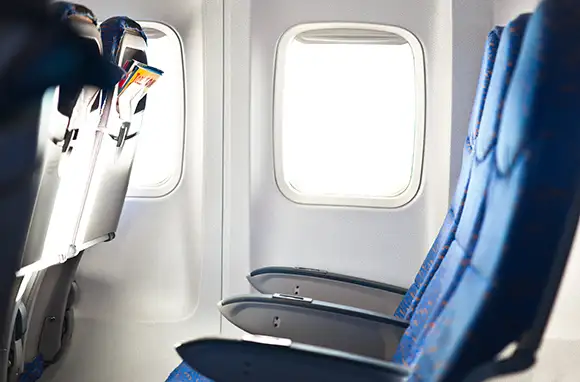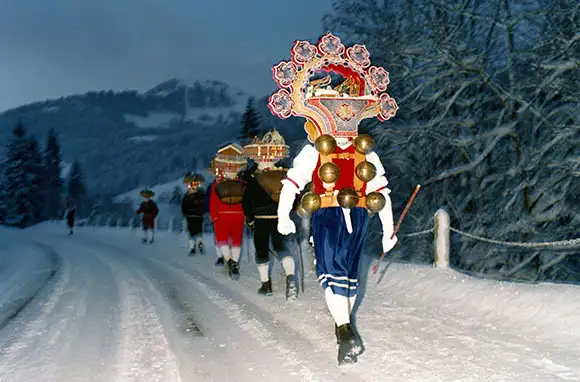
Europe is inundated with stampedes of tourists during warmer months, driving up costs for flights and hotels and blocking your view of the Mona Lisa. Accordingly, winter’s the natural choice for the crowd-phobic and cash-strapped. But there are plenty more pros to a low-season jaunt across the pond, which I discovered during a trip to snowy Amsterdam a few weeks ago. We’re still in the thick of winter, so pack your bags and take advantage of the following 10 unexpected benefits of traveling to Europe in the off-season.
Image Gallery

Instant Free "Upgrade"
Planes are flying at full capacity now more than ever, and many airlines charge additional fees for the jackpot economy seats—those with an inch or two of extra legroom, seats near the front of the plane, or even coach spots neighboring vacant seats. Air New Zealand charges up to $800 on top of original ticket costs for Economy Skycouch, a set of three empty seats with footrests and armrests that can flip up, transforming the row into a veritable chaise lounge.
I got my own "skycouch" free of cost on a January flight to Amsterdam. My flight was at less than 50 percent capacity, which isn't that unusual for a weekday winter red-eye to Europe. There were empty rows in every direction, and I was able to lie flat across three seats (granted, I'm petite), commandeer the extra blankets and pillows resting on nearby empty seats, and slumber in peaceful solitude. During low season, the odds are decent that you'll find yourself in a similarly barren cabin. It's fantastic.
Bonus: that puffy winter coat you're bringing? It makes the best in-flight pillow, ever.

Instant Free "Upgrade"
Planes are flying at full capacity now more than ever, and many airlines charge additional fees for the jackpot economy seats—those with an inch or two of extra legroom, seats near the front of the plane, or even coach spots neighboring vacant seats. Air New Zealand charges up to $800 on top of original ticket costs for Economy Skycouch, a set of three empty seats with footrests and armrests that can flip up, transforming the row into a veritable chaise lounge.
I got my own "skycouch" free of cost on a January flight to Amsterdam. My flight was at less than 50 percent capacity, which isn't that unusual for a weekday winter red-eye to Europe. There were empty rows in every direction, and I was able to lie flat across three seats (granted, I'm petite), commandeer the extra blankets and pillows resting on nearby empty seats, and slumber in peaceful solitude. During low season, the odds are decent that you'll find yourself in a similarly barren cabin. It's fantastic.
Bonus: that puffy winter coat you're bringing? It makes the best in-flight pillow, ever.

Local Winter Traditions And Activities
The chance to partake in yuletide celebrations in Europe, from Christmas markets to festivals of lights, is a plain advantage to heading to the Continent during winter. But what about the less obvious—but just as magical—local traditions that last throughout the season? Enjoy the scent of peat burning in the fireplace at a country B&B in Ireland, skate on the canals in Amsterdam, or sleep in an igloo village in the Swiss Alps. Winter sports like skiing, snowshoeing, and dog sledding are a big draw, too. And then there's the modern tradition of the post-Christmas retail sales, which will soften the blow of the unfavorable European exchange rate when you feel the urge to shop.

See a Familiar Destination in a New Way
I'm an Amsterdam superfan, nuts about the city's friendly locals, bike culture, incredible diversity, history of tolerance, and overall abundance of life and energy. And, of course, there's the canal ring, a living museum that amazes from every angle, in any kind of weather. Until recently, though, I had only visited the Dutch capital during high season. So on my first winter trip there, instead of longing for the balmy, bright Amsterdam of spring and summer, I fell in love (all over again) with the snowy version: the frozen canals, the haphazard sidewalk snowmen, the moody afternoon sunsets.
If there's a special spot in Europe to which you keep returning, visit during winter. You'll have a completely different experience, and you'll get a fresh perspective on your cherished destination.

It's Easier to Plan a Last-Second Trip
Feeling spontaneous? A low-season trip is the ticket to planning a successful jaunt with just days until departure. During high season in the more popular European destinations, the most in-demand hotels, B&Bs, and vacation rentals fill up months in advance. During winter, though, it's surprisingly easy to get a bargain-priced room at a highly rated property, even when booking just days in advance. You'll also find it a cinch to grab last-minute tickets to festivals and big events happening during the season. The same goes for tickets to attractions and seats at in-demand restaurants.

Go Local
Does your idea of seeing a destination involve getting to know those who live there? If yes, then a low-season trip is a smart choice. In summer, I've found myself at countless bars and restaurants in Europe that were abundant with Americans—enough to make me feel as though I hadn't really traveled anywhere. This is not the case during low season, when natives clad in coats and boots reclaim restaurants and cozy pubs.
In Amsterdam, I had no trouble getting to know the bartender at a popular bruin cafe, who broke down the nuances of Dutch politics at length. In fact, I was surrounded by Dutch-speaking locals almost wherever I went, even in popular bars and restaurants that I remembered being crowded with international tourists during warm-weather months. It was like I was getting an exclusive insider's look at local life in the city.

Thermal Spas and Bubble Baths Beckon
Say "spaah" in European destinations where heated waters feel especially divine during wintertime. There's the Blue Lagoon in Iceland, the Szechenyi thermal bath in Budapest, and the Thermae Bath Spa in Bath, as well as any number of Nordic spas and steamy wood-fired saunas across Scandinavia. But even a nightly steep in your hotel's copper soaking tub could turn out to be the best part of your trip on a winter getaway.
Seek out amenities like heated bathroom floors, Jacuzzis, or deep tubs. Pay a little extra for a room upgrade if you must. Hotel rates are already much more affordable during low season, so why not treat yourself? After all, there's absolutely nothing like a relaxing dip in steamy water at the end of a cold winter's day.

Gorgeous Photography
Photography buffs would do well to jet across the pond in the low season. Iconic yet widely photographed attractions (like the Eiffel Tower) become more original shots (like the Eiffel Tower surrounded by snow flurries). The low-slung winter sun has a beautiful, atmospheric effect on European cityscapes. And you'll often have sought-after attractions, from museum exhibits to monuments, all to yourself—so no contending with hoards of people when angling for the perfect shot.
Additionally, there's one wonderful snapshot you won't likely get during summer: the aurora borealis. Take gorgeous photos of winter landscapes lit up beneath the vibrant green or red sky when visiting destinations like Iceland or Norway.

Tasty Winter Foods
So many classic European foods seem designed for consumption (and comfort) during colder months: hot mince pie in London, fondue in Switzerland, steamy borscht, Polish stews, and mulled wine. Since many higher-end restaurants change their menus with the seasons, you can experience a new dimension of local cuisine when visiting your favorite establishments in Europe in the off-season.
Moreover, during summer, you might not get to try some of the scrumptious foods that are more widely served in Europe in winter. For example, calcots, Catalan vegetables similar to scallions, are traditionally grown from February through March and are a wildly popular winter and early-spring snack in Spain. Calcots are normally grilled and served with a garlicky romesco dip—they're big in Barcelona.

Cozy Cafes
Afraid you'll miss the vibrant sidewalk-cafe scene when traveling to Europe during winter? You won't—not if you stay on the lookout for cafes that get creative with outdoor seating. Lots of establishments set up tables and chairs among outdoor heaters or cozy spaces with blankets and pillows. I found a fabulous cold-weather people-watching nook at Amsterdam's Cafe Wheels, pictured above. Situated near a busy canal street, the cafe had a padded bench piled with warm wool blankets. It was sublime to curl up on the bench with a blanket, a good book, and a cappuccino, and watch the crowds pass.

Escape The Frost
Not a winter person? Your winter trip to Europe could prove a respite from frigid temperatures in your home base if you head to the parts of the continent that have a milder, Mediterranean climate. Enjoy the benefits of low season sans frigid winds and icy sidewalks in destinations like the south of France, southern Italy, Greece, and southern Spain. For example, according to Weather.com, the average high in Naples is 55 degrees in February and 59 degrees in March.
Winter is still the low season in these destinations, offering scant crowds and lower prices, yet it won't be as cold as more northern European destinations, and you might even enjoy a sunny, balmy day or two with 60-degree temperatures.
More From Smartertravel:
We hand-pick everything we recommend and select items through testing and reviews. Some products are sent to us free of charge with no incentive to offer a favorable review. We offer our unbiased opinions and do not accept compensation to review products. All items are in stock and prices are accurate at the time of publication. If you buy something through our links, we may earn a commission.
Related
Top Fares From
Today's Top Travel Deals
Brought to you by ShermansTravel
France: 8-Night Paris, Avignon & Nice...
Infinity Worldwide Vacations
 vacation
$2880+
vacation
$2880+
Poconos: 3 Nts in Garden of...
ResortsAndLodges.com
 hotel
$305+
hotel
$305+
7-Nt Canada & New England Cruise,...
Princess Cruises
 cruise
$839+
cruise
$839+



